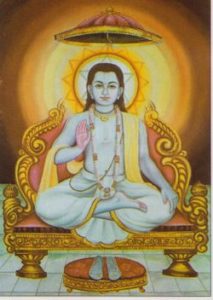Nimbarkacarya – Acarya Sri Nimbaditya
- by Srila Bhaktisiddhanta Saraswati Thakur Prabhupada
In ancient times there was a city named Vaidurya Pattna in the country of Tailanga Desh [probably the modern Indian state Telangana]. At present, this city is known as Mungera Pattana, or Mungi Patana. In that city lived a pious sage named Aruni, who was a devotee of Lord Vishnu and whose wife was named Jayanti Devi. It was said that he was a descendent of Aruna Muni, who came to the assembly of King Parikshit, as described in Śrīmad Bhāgavatam 1.19.11.
At the end of Dvāpara-yuga, when the sky of bhāgavat-dharma was covered by the fog of duplicity so that people in general were distracted from the path of devotional service to the Supreme Lord, which is the constitutional duty of all living entities, being overcome by petty material desires, the supremely merciful Lord Vishnu, in order to protect pure sanātana-dharma, decided to send an empowered incarnation to the holy land of Bhārata-varṣa.
Thus a jewel-like child, as brilliant as the sun, appeared in this world in the evening of the full moon day of the month of Karttika as the son of Srimad Aruni and his wife, Sri Jayanti Devi, who were both devoted to Lord Vishnu, thus enhancing the happiness of the devotees. Aruni Muni dutifully performed all the prescribed Vedic saṁskāras for his jewel-like son, and then sent him to gurukula so that he could study the scriptures under the guidance of a qualified spiritual master.
In a very short time the wonderful boy surprised everyone by displaying his genius in mastering all the Vedas and branches of the Vedas, and exhibiting his propensity for spiritual realization.
This bright sun-like personality grew up while observing a vow of strict celibacy. Then, for the purpose of propagating eternal vaiṣṇava-dharma, he accepted the renounced order of life according to prescribed rules and regulations.
After accepting sannyāsa, he set out for Nandagram in Vraja, hoping to have the darśana of Lord Krishna.
There, at Nandagram, he composed a beautiful prayer consisting of twenty-five verses known as Saviśeṣa-nirviśeṣa-śrī-kṛṣṇa- stava, and offered it at the lotus feet of his worshipable Lord. He constructed a cottage near Govardhan Hill and exhibited the ideal example of how one should worship Lord Krishna by performing unalloyed devotional service. The place where he performed bhajana after constructing a cottage is at present known as Nimbagram.
It is said that one day a sannyāsī from a Jain sampradāya came to Mathura and invited all the learned scholars there to a debate on the scriptures. This Jain sannyāsī scholar desired to conquer the entire country by proving the uselessness of Vedic religious principles. However, the vaiṣṇava ācārya from Vaidurya Pattna effortlessly refuted all the arguments put forward by the Jain sannyāsī by quoting scriptural evidence.
The Jain sannyāsī, after being defeated, took shelter of the vaiṣṇava ācārya. The vaiṣṇava ācārya thus accepted him as a disciple and then instructed him in the true meaning of Vedic religious principles.
It is said that after the scriptural debate commenced between the Jain sannyāsī and the vaiṣṇava ācārya, it continued for a long while. Finally, the vaiṣṇava ācārya, realizing that the sun was about to set, offered some remnants of Lord Vishnu to his guest, who had come to his āśrama, to relieve him of his fatigue. Jain sannyāsīs are prohibited to eat anything in the evening or at night, and so at first he refused to honor the prasāda. Because of this, the vaiṣṇava ācārya climbed a neem tree and held the sun above the horizon until the sannyāsī could finish his meal. According to one rendition of this story, he climbed a neem tree and then invoked the Lord’s sudarśana cakra in the sky. As the cakra, which was as effulgent as the sun, appeared, the sannyāsī thought it to be the sun.
Because he climbed a neem tree and manifested arka, or āditya (the sun), he became known as Nimbarka, Nimbaditya, and Nimba Vibhavasu. At some places he was known as Aruneya, Niyamananda, and Haripriyacharya. Some people say that Nimbarka appeared in this world at the time when Krishna’s great-grandson, Vajranabha, was the king of Mathura. The disciplic succession of Sri Nimbarka is mentioned in a commentary on the eighth sutra of the third section of the first chapter of Vedānta-darśana:
paramācāryaiḥ śrī-kumārair asmad-gurave śrīman- nāradāyopadiṣṭaḥ
The exalted ācārya, Sri Sanat Kumar, was a great sage. His disciple was Sri Narada and Narada’s disciple was Sri Nimbarka.
Sri Nimbaditya’s commentary on Vedānta-sūtra is known as Vedānta-parijata-saurabha. Sri Nimbarka’s disciple, Srinivasacharya, elaborated on that commentary by presenting another commentary called Vedānta- kaustubha. Keshava Kashmiri, who was a contemporary of Sri Chaitanya Mahaprabhu, accepted the Nimbarka sampradaya and composed an explanation of Vedānta- kaustubha called Kaustubha-prabhā.
— From The Life and Teachings of the Four Acaryas by Srila Bhaktisiddhanta Saraswati Thakur. Jai Nitai Press. 2007.
Post view 785 times



